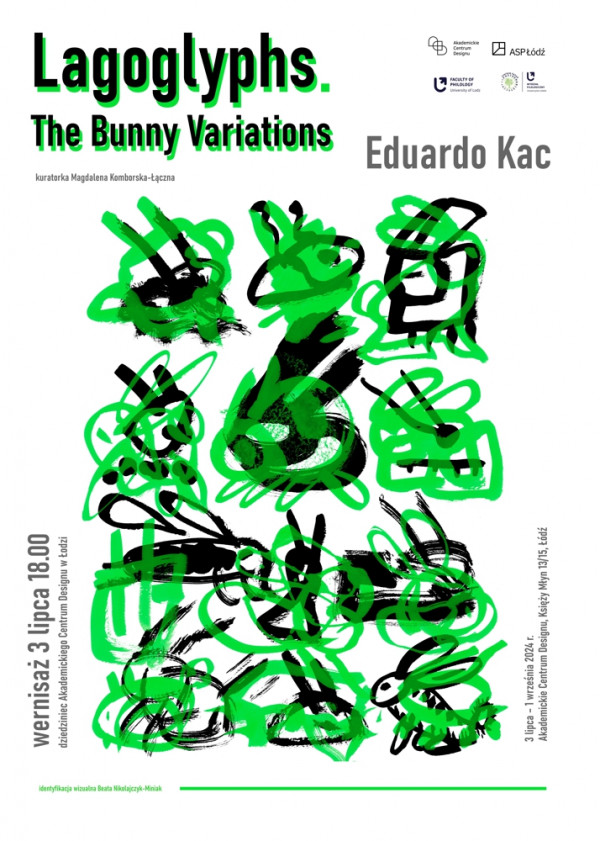EDUARDO KAC. „Shining LAGOGLYPHS”
In 2000, with the use of genetic engineering techniques, Eduardo Kac created the artwork GFP Bunny, through which Alba, the rabbit, began her life when a fluorescent gene from a jellyfish was implanted into a rabbit egg. The albino rabbit with pink eyes glowed fluorescently green in the corresponding blue light. With Alba, the "Lagoglyph" series was born — a "rabbitographic" form of communication. For his solo show at the Academic Design Center in Lodz, Kac will premiere a new set of Lagoglyph Lux sculptures as well as the fifth in his Lagoogleglyph series of works conceived to be seen via satellite.
The first in the "Lagoglyph" series was a "leporimorphic" work (another kacyism) entitled "Lagoglyphs: The Bunny Variations" (2007). The lagoglyphs form an invented script with ever-changing characters. Another is "Lagoglyph Animation" (2009) which creates custom software that runs in real time, thus generating a parametric animation. Never repeating, it combines Kac’s lagoglyph drawings to create something new. The event of the Eyjafjallajökull volcano eruption that paralyzed Europe beyond its borders inspired Kac, who began work on the "Volcano Paintings" (2010). The hybrid lagoglyphs took the shape of an explosive, destructive form and show/translate the Alba "rabbit" into a new, generative and molten matter. The fourth (but not the last) permutation of the "Lagoglyph" series is "Lagoglyph Porcelain" (2011), through which the series emerges in three-dimensional space. Composed of black and hand-mixed green layers that form the outline of the Alba rabbit, it was rendered in very fine porcelain.
The "Lagoglyph" series, according to critic Brian Droitcour, is a vivid and "liquid poetry," defined as a language that "appears online in time as a flow, (...)."
Kac’s new "Lagoglyph" set consists of two laser-cut module elements, with one in green (transparent) and one in black (opaque). The 20 sculptures set in a flowing wavy structure in space undergo the effect of light scattering. Spreading around the viewers, the contoured light rays in bright green color communicate through luminous variations, as both natural and artificial light interact through reflection, difraction, absorption, and diffusion. Following Plato, it can be called not the "second fire" (that is, the light that is associated with the earth and forms an ideal entity with it) but the "third fire", which is associated with the speed and new color of light. The flash of light was interestingly defined by French sociologist Paulo Virillio, who proposed that in place of chronological systems (time taken as a linear succession of moments), the rhythm of the elements (past, present and future) has entered a chronophotographic system with a new rhythm constitued by underlighting, illumination, overlighting. The "Lagoglyphs" can thus be associated with a new time system. When viewed from the perspective of the artist, the "Lagoglyphs" give shape to Eduardo Kac's personal and natural means of expression (according to Władysław Strzemiński's "Theory of Vision", each type of consciousness pattern uses a specific means of expression). "Every new set of means of expression is at the same time a new set of formal means. Thus, changes in formal means result from a change in the visual base, from a change in the type of vision that defines the relationship between humans and nature."
The new, laser-cut "Lagoglyphs" are somewhere between natural and stimulated light. They can be perceived individually, but taken together they form a compact form of diffused rays against which the viewer can walk in a luminous composition of "receptio luminum" or a spatial "luminous image" (according to Virillio). This is an amazing situation because viewers move smoothly along, unleashing an experience that is comparable to an escape from the prison of their own bodily senses, surrendering to the arms of the artist’s extraordinary vision of light.
Kac’s exhibition includes a new video work (Lagoogleglyph #5). It is one of the five on display, from a series that captures the scale of not only light but mainly the cosmic dimension of Alba's "eye". The Lagoogleglyphs are physical works installed in different locations to be seen via satellite and easily accessible online. They offer a panoramic view of the Universe from human and non-human positions, having the Earth as the point of reference while living and non-living matter float in the direction of the zooming eye.
Magdalena Komborska-Łączna
Author
EDUARDO KAC
Visual Identity
Beata Nikolajczyk-Miniak
Curator
Magdalena Komborska-Łączna
Vernissage
July 3 at 6 p.m., P1_Academic Design Center
Exhibition dates
3.07 – 01.09.2024 r.
Venue
P1_Academic Design Center
Księży Młyn Street 13/15, Łódź
FREE ENTRANCE
Organizers
Academic Design Center and the Academy of Fine Arts in Lodz, University of Lodz Faculty of Philology, Posthumanities Research Center


